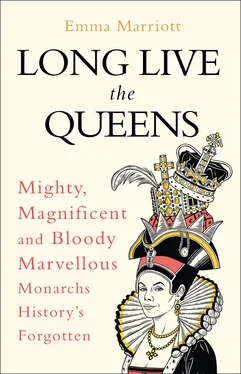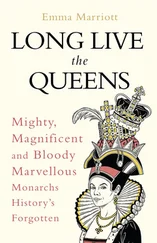As a medieval queen, her role was also a political one, requiring her to foster good relations at court, whilst also mediate and smooth over family and dynastic disputes. As in Normandy, Matilda gave judgements and heard pleas jointly with William in English courts and he gave her the authority to hear lawsuits over land disputes, as mentioned several times in the Domesday Book. She witnessed many royal charters, some jointly with William, her name appearing below his but above their sons (although, as neither could write, they marked their names with a symbol, she with a Jerusalem cross).
As William battled to consolidate his rule in England, particularly in the troublesome north of the country, it was said that a heavily pregnant Matilda travelled some 200 miles to be with her husband and that their fourth child Henry was born just south of York in late 1068. The subsequent year saw further resistance in the north, culminating in William ordering a violent annihilation of entire villages and the burning of crops and herds. During this tumultuous time, he sent Matilda back to Normandy, where she again ruled in William’s stead, bringing up their children, issuing charters and attending Councils of State. In England, William continued to establish his rule, bestowing land and titles to Norman barons and encouraging them to raise fortified castles across the kingdom. By 1072, the conquest was more or less complete, largely at the expense of the Saxon population, who were savagely oppressed by the new Norman aristocracy.
In 1074, Matilda was briefly again made Queen Regent of Normandy, the same year that she and William lost their second son, Richard, in a hunting accident. In 1076, trouble flared between William and their eldest son, Robert, on whom Matilda doted but who proved a disappointment to his father, his short stature, ‘pot belly’ and fat legs earning him the unflattering moniker of Robert ‘Curthose’. Officially, Robert was Duke of Normandy, but he was frustrated by his father not granting him full autonomy, a resentment that broke out into open hostilities in 1078 as the King fought a three-week siege against Robert, during which father and son actually fought, with the King’s horse killed and his hand wounded. Not unsurprisingly, the feud greatly distressed Matilda, and it was soon discovered that she had been secretly sending Robert large sums of money, much to the fury of William. When he confronted Matilda, she stood her ground, pleading maternal devotion, for which William eventually forgave her: father and son were formally reconciled in 1080.
By the early 1080s, Matilda’s health was beginning to suffer and she died in November 1083, around the age of fifty-two. After thirty-three years of marriage, William was apparently inconsolable, some saying from thereon ‘he abandoned pleasure of every kind.’ Matilda was buried at the convent of the Holy Trinity at Caen. Her passing was mourned throughout France, and it was claimed she was ‘wept for by the English and the Normans for many years’. She had proved herself a most able ruler, one who wielded great power and influence in Normandy and England, who was by turns an ambitious consort, a wise counsel, a capable leader and doting mother – a queen who deserves much greater acclaim, for being both a powerful ally to William the Conqueror and ruler in her own right.


Born: 624 CE
Died: 705 CE
Some fifty miles northwest of the modern Chinese city of Xi’an, deep within Mount Liang, is the tomb of Empress Wu Zetian. There lies the remains of an Empress of China who ruled for more than fifty years during the Tang dynasty (610–907 CE), the only woman in 3,000 years of Chinese history to have sat on the Chinese throne as ruler in her own right.
And yet the great memorial tablet that stands at the entrance to her tomb, erected during her lifetime so that her successors could compose the usual epitaph proclaiming her worthiness as empress, remains starkly blank. By contrast, the tablet that immortalises her husband, Emperor Gaozong, buried in the same mausoleum, carries the usual inscription recording his deeds as emperor, as composed by Wu Zetian to a husband whose death preceded hers by some twenty years.
The lack of inscription on Wu’s memorial, the only one of its kind, was clearly an attempt to obscure any record of Wu Zetian’s rule; she died and lies near to her husband but any other details are best forgotten. The omission also reflects how she was perceived by people around her and successors – in particular the Confucian hierarchy who deeply disapproved of her and the idea of any women having genuine power, deemed as unnatural as having a ‘hen crow like a rooster at daybreak’.
Despite attempts to remove her from record, Wu Zetian is now an immensely famous figure in China – the subject of books, films and TV shows – although she is still largely unknown in the West. Much of her fame, however, rests on her startling propensity for ruthlessness: murdering female rivals, elder statesmen who opposed her, and even members of her own family so that she could wield supreme power. Her image is that of a murderous megalomaniac, almost as if a warning of what a woman can do when given enough power, an image that has in the past overshadowed the many achievements of her reign.
Born in 624 CE, Wu Zetian (original name Wu Zhao) entered the palace of the Tang emperor Taizong in 638 as a fourteen-year-old concubine. As the daughter of a minor general, this was deemed quite an honour, although her role at first would largely be as a glorified serving woman. Little is known about her life as a concubine but it’s thought she managed to get close to the Emperor when her duties included changing the imperial bed sheets. When the Emperor died in 649, the custom was for concubines to have their heads shaved and be sent to a convent, where they would remain for the rest of their lives. Taizong’s heir, Gaozong, however, brought Wu back to the palace as his favourite concubine, her rise in status brought about, as some Chinese historians have speculated, by her willingness to gratify emperors’ unusual sexual appetites.
Having given birth to two sons, Wu had a daughter in 654 who died soon after. Wu accused the wife of Gaozong, Empress Wang, of strangling the child in a fit of a jealousy over her own childlessness, although other histories of the period claim Wu smothered the child herself only then to blame the Empress for the death. Wang was subsequently demoted and imprisoned along with another leading concubine. It is said that Wu, who had now replaced Wang as Empress Consort, ordered that both women have their legs and arms cut off and their torsos thrown into a vat of wine, leaving them to drown – an account suspiciously similar to the revenge act of a previous empress, Lu Zhi (241–180 BCE), who is held up in Chinese history as one of the most wicked female rulers.
As Empress, Wu set about removing officials who were opposed to her elevated status on the grounds that she was not of an aristocratic background and as a former concubine of Taizong, her relationship with Gaozong was incestuous. In 660, Gaozong suffered a stroke – although some historians have claimed that Wu Zetian poisoned him – and he remained in poor health for the rest of his life. Wu in effect took charge and continued exiling and executing potential rivals, some from her own family, including possibly her sister and brothers, her teenage niece, who had caught Gaozong’s eye, and Wu’s eldest son Li Hong, who in 675 died suspiciously, some believing that he was poisoned by the Empress.
Читать дальше








![Джеффри Арчер - The Short, the Long and the Tall [С иллюстрациями]](/books/388600/dzheffri-archer-the-short-the-long-and-the-tall-s-thumb.webp)





